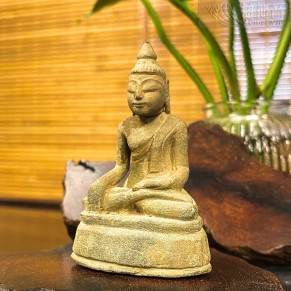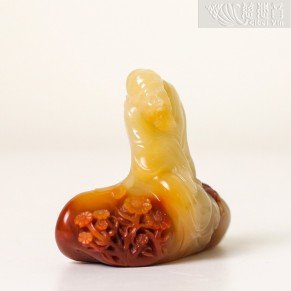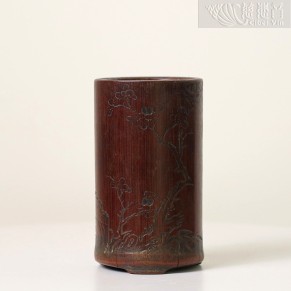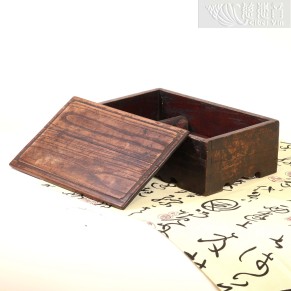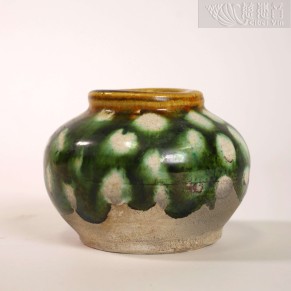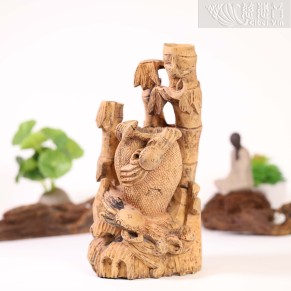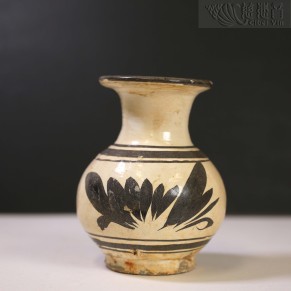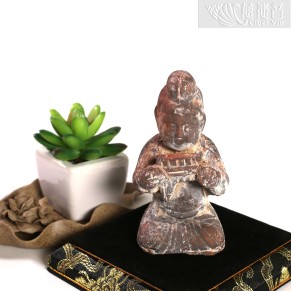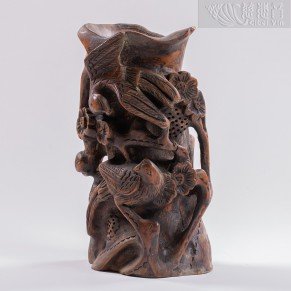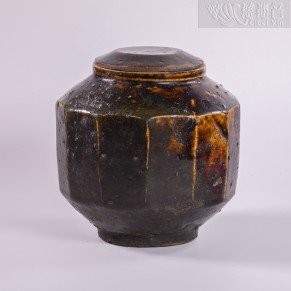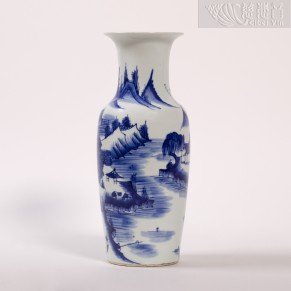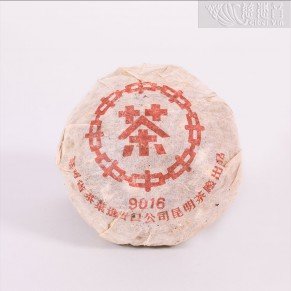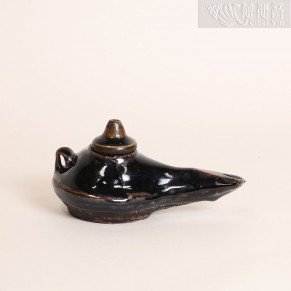Malaysia Zone
-
Seated Buddha Sculpture in Burmese Sandstone
Material: Sandstone
Size: 4cm long x 2.5cm wide x 6cm high
Dating back approximately 800 years, this Buddha image originates from the golden era of the Pagan (Bagan) Dynasty in Myanmar, and was once an object of royal devotion.
The Pagan period is considered the pinnacle of Burmese Buddhist art. Despite the passage of centuries, this statue remains remarkably well-preserved, radiating a profound spiritual presence—an enduring testament to the artistic and devotional legacy of its time.
The Buddha is depicted in a full lotus posture atop a double-lotus pedestal. His right hand performs the Bhumisparsha mudra—“the earth-touching gesture”—symbolizing the vanquishing of inner demons and the unwavering strength of his vows. The left hand rests gently on the knee, the expression serene and compassionate, exuding wisdom and inner calm.
The overall form is dignified and poised. The proportions are harmonious, the facial features solemn yet peaceful, and the surface retains the quiet elegance of aged stone, evoking a timeless, contemplative stillness.
Encircling the base is a band of relief-carved concentric motifs, symbolizing the radiant light of the Buddha’s infinite merits and wisdom—illuminating and protecting the land, bringing peace to the people, and blessings to all sentient beings.
Learn MoreUS $18,000 -
Affinity for Chrysanthemums by the Deep – Shoushan Stone Sculpture by Shilu
Material: Shoushan Stone
Size: Length 7.4 x Width 3.3 x Height 6cm
Inscription: “Yuanming Loves Chrysanthemums – Winter of the Guiyou Year, by Shilu”
This piece is the work of renowned contemporary carving artist Shilu, finely sculpted from delicately textured and lustrous Shoushan stone. The artist skillfully employs the natural coloration of the material, executing the form with fluid grace and meticulous precision. The craftsmanship is both technically masterful and rich in spirit, endowing the work with vivid presence and refined elegance.
The subject depicts the revered poet Tao Yuanming in a state of tranquil repose, leaning gently as chrysanthemums bloom beside him—a visual echo of his noble character and his retreat from worldly affairs to a life of rural simplicity. The natural stratification of red and yellow tones in the stone lends striking contrast between the figure and the flora, enhancing both the depth of the scene and the poetic ambiance it evokes.
The chrysanthemum, one of the Four Gentlemen of traditional Chinese flora, symbolizes purity, longevity, and serene detachment. This work embodies not only the spirit of reclusive literati but also an ideal of harmony, virtue, and inner freedom. Graceful as a desk ornament and rich in cultural symbolism, it holds lasting value as both a collectible and a legacy piece.
Learn MoreUS $28,000 -
Qing Dynasty Bamboo Brush Pot with Plum and Bamboo Motif
Material: Bamboo
Specifications: Diameter 7.4 x Height 12.8cm
This bamboo brush pot dates back to the Qing Dynasty and is meticulously carved from a single piece of aged bamboo. Selected for its fine quality, the bamboo boasts a smooth texture and a naturally rich patina developed over time.
The carving theme, titled "Plum and Bamboo — The Two Purities", features intertwining plum blossoms and bamboo branches rendered in a combination of low relief and openwork techniques. The plum symbolizes resilience in the face of winter, while the bamboo stands for uprightness and strength—both revered symbols of purity and moral integrity in traditional Chinese literati culture.
Brush pots have long been one of the essential tools of a scholar's studio, admired not only for their elegance but also for their auspicious symbolism. When placed on the desk, they are considered Feng Shui treasures believed to attract wealth, wisdom, virtue, and talent. It is customary to place at least two or three brushes of varying lengths inside, symbolizing the wish for continuous advancement in career and learning—“rising higher with each step.
Learn MoreUS $8,800 -
Huanghuali Wood Inkstone Case for the Scholar's Studio
Material: Sandstone
Size: 4cm long x 2.5cm wide x 6cm high
Early Qing Dynasty, approximately 200 years old.
This refined scholar’s box was crafted from precious Huanghuali wood, a prized material in traditional Chinese furniture-making. Judging by its current hue and weight, the box was made using superior-grade hardwood, joined with classic mortise-and-tenon construction—a hallmark of exceptional craftsmanship.Designed as an essential item for the traditional scholar’s studio, the box was intended to house an entire set of literati tools: inkstone, brushes, and ink. Compact and elegant, it offered both function and portability, making it ideal for travel or refined desk display.
Beyond its utility, this treasured chest carries auspicious symbolism—it is believed to gather blessings, virtue, wisdom, and talent. May the one who acquires it be upright in conduct, brilliant in learning, abundant in wisdom, and destined for success and honor in all endeavors.
Learn MoreUS $3,800 -
Liao Dynasty Sancai 'Fortune Accumulating' Jar -1
Material: Ceramic
Specifications: Diameter 9 x Height 6.7cm
Liao Sancai, or "Three-Color Ware of the Liao Dynasty," emerged over a thousand years ago during the Liao and Song periods. Characterized by its use of yellow, green, and brown glazes, it inherited the traditional techniques of Tang Sancai while incorporating the distinctive artistic sensibilities of the Khitan people.
This antique jar, with its considerable age and remarkable preservation, is far more than a simple vessel. It is revered as an auspicious object—believed to gather blessings, prosperity, and harmonious energy, serving not only as a decorative artifact but also as a talisman to balance Feng Shui, ward off misfortune, and protect the home.
Learn More
US $9,800 -
Liao Dynasty Sancai 'Fortune Accumulating' Jar -2
Material: Ceramic
Specifications: Diameter 8.6 x Height 5.4cm
Liao Sancai, or "Three-Color Ware of the Liao Dynasty," emerged over a thousand years ago during the Liao and Song periods. Characterized by its use of yellow, green, and brown glazes, it inherited the traditional techniques of Tang Sancai while incorporating the distinctive artistic sensibilities of the Khitan people.
This antique jar, with its considerable age and remarkable preservation, is far more than a simple vessel. It is revered as an auspicious object—believed to gather blessings, prosperity, and harmonious energy, serving not only as a decorative artifact but also as a talisman to balance Feng Shui, ward off misfortune, and protect the home.
Learn More
US $6,800 -
Rolling Fortune and Rising Success Bamboo Pen Holder
Material: Wood
Specifications: Length 11.5 x Width 9 x Height 22cm
The density and weight of the wood are comparable to boxwood, and it exudes a subtle natural fragrance.
Judging by the grain and tightness of the wood, it was carved from timber that had grown for nearly a hundred years—a material of remarkable rarity and value.The crab is exquisitely carved with lifelike detail, especially on its back, where a "coin-shaped" motif has been intricately inscribed. This symbolizes the "wealth crab", representing money steadily flowing into the basket. Surrounding the crab are sculpted bamboo stalks, further enhancing the auspicious symbolism.
Altogether, the piece conveys a beautiful traditional blessing: abundant fortune steadily accumulating, and continuous success and advancement—“wealth flowing in, and rising step by step.”
Learn MoreUS $68,888 -
Prosperity Vase with Lotus Motif
Material: Ceramic
Specifications: Diameter 8.8 x Height 10.7cm
Liao–Song Period (ca. 1000 years ago)
This elegant bottle dates back to the Liao–Song period, with a history spanning nearly a millennium. The body is coated in black-and-white glaze, with rustic and organic motifs. Its form is well-proportioned, featuring a gently constricted neck and flared rim, with flowing lines that exude quiet harmony and rhythm.
Encircling the bottle are three bands, symbolizing the union of Heaven, Earth, and Humanity—a reflection of the traditional cosmological ideal of harmony between the universe and mankind. The central motif is a stylized lotus blossom, rendered in abstract brushwork. Graceful and upright, the lotus represents purity, wisdom, and noble virtue, and in Buddhist thought, it is a sacred emblem of awakening and transcendence.
This treasured vessel has been blessed and empowered by Grandmaster JinBodhi, imbuing it with auspicious energy. It is believed to attract wisdom, virtue, blessings, prosperity, and noble fortune, while harmonizing Feng Shui, warding off negativity, and serving as a protective presence within the home.
Learn MoreUS $12,800 -
Court Lady Playing Xiao – Glorious Tang Era Figurine
Material: Ceramic
Specifications: Length 5 x Width 5.7 x Height 10.8cm
This elegant terracotta figure hails from the flourishing Tang Dynasty, portraying a court lady seated gracefully as she plays the "paixiao" (panpipes).
With her hair styled in a high chignon and her hands gently holding the ancient wind instrument, she sits in poised serenity. Her face is full and rounded, features delicately refined, and expression calm yet gently smiling—as if immersed in the music, content and at ease, radiating quiet charm and grace.
The sculpting throughout is exquisite: flowing drapery lines, finely rendered details, and lifelike form together showcase the Tang dynasty's mastery of ceramic artistry and aesthetic sensibility. Though it has withstood the passage of over a thousand years, the piece remains remarkably well-preserved, its spirit and vitality still vividly present—an exceptional work of enduring cultural value.
The paixiao in her hands was a common court instrument in ancient China, symbolizing elegance, music, and the flourishing of ceremonial culture.
Learn More
This piece, steeped in the refined atmosphere of Tang palace art, not only reflects the composure and elegance of Tang women, but also conveys auspicious meanings of prosperity, harmony, joy, and well-being—hallmarks of a glorious age.
US $3,800 -
Magpie Climbing Brush Pot
Material: Kyara
Size: 7.5*8.3*高15.5cm
Kyara, a type of agarwood, is very precious and has a pleasant fragrance. For items such as flower vases or brush pots, the diameter of the wood used is quite large considering the size of the finished product. Thus, using such valuable agarwood for large carvings is something only extremely wealthy families can afford. These are rare carved pieces.
Learn MoreUS $38,000 -
US $8,888
-
Kangxi Prosperous Era Blue and White Porcelain Vase from the Qing Dynasty
Material: Porcelain
Size: 12*H29.5cm
Era: Kangxi Prosperous Period
The blue and white coloration is beautiful, and the craftsmanship is meticulous, making it a rare and perfect piece.
Symbolism: Abundance, peace, beauty, prosperity, thriving, flourishing, great wealth, unification of the realm
Learn MoreUS $68,000 -
9016 Ripe Pu'er Old bowl-shaped compressed mass Tea (1990)
Size: diameter 10*height 5.5cm
Weight: 230g / a tea cake
Precautions before placing an order for tea(please click)
【Live excerptBenefits of Pu-erh Tea】
Learn MoreUS $2,800 -
Ming Dynasty Beast-Handle Xuande Incense Burner
Material: Copper
Specifications: Outer diameter 13 cm, maximum diameter 16.3 cm, height 7 cm
In ancient times, large copper cauldrons symbolized imperial power. An incense burner is a smaller representation of a cauldron. The smoke rising from burning incense signifies ascension and is a symbol of pure yang energy, representing prosperity.
Blessings received by the devotee:
Increased authority and prestige. Career advancement and success.
Learn More
Thriving incense offerings. Incense represents the descendants of a family, signifying a prosperous and flourishing lineage.
Harmony in the family, attracting good fortune, and happiness in reunion.
It also serves as an offering vessel before gods and Buddhas, gathering auspicious energy and blessings. It can carry and contain, symbolizing generational inheritance.US $28,000


